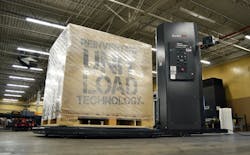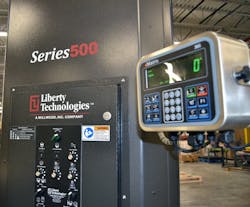Benefits of providing standard, modified-standard or custom-engineered designs
Part of our OEM Spotlight Series --
Combining standard designs with the capability to engineer unique, turnkey systems, based on the customer's needs, has helped Millwood in Vienna, Ohio, to stretch and grow. "Having the engineering resources needed to provide customers with the best solution, standard or custom-engineered, depending on the product type, is critical," states Rich Evick, senior vice president at Liberty Technologies, a Millwood company.
Millwood started in 1996 when Chip Trebilcock and Steve Miller became business partners after each owning his own pallet company. "Millwood has over 20 years of creating unique turnkey systems," states Evick. "In 2005, Millwood acquired Liberty Technologies and its line of stretch-wrapping equipment. Last year, the third owner, Ron Ringness pushed Millwood to $325 million in revenue."
Millwood is approaching 1,600 employees in its domestic operation of 28 facilities, encompassing transportation, packaging, corrugated, RFID and material handling products, comments Evick. "We have 25 technical engineers within our company assisting customers with project specifications and application support, as well as continuing to enhance our in-plant processes," he continues.
A full-service team of service technicians, electrical and mechanical engineering are on Millwood’s staff for installations and startups; and there’s a programming staff, says Evick. "We also offer online support systems, as well as Liberty Direct, an ecommerce site that offers replacement parts," he explains.
What's best for the customer
Millwood products serve almost all industries, including packaging and material handling; food and beverage, automotive, steel, glass, paper products, brick and block, distribution warehousing and more, notes Evick. "We pride ourselves on being solutions providers for our customers, working with them to define the applications that are best-suited for their needs," he says.
Also read: Conveyor builder grows its product lines and its facility size
Figure 1: Liberty Technologies has the engineering to provide the proper stretch wrapper unit load technology solution.
Source: Millwood
The Ohio machine builder provides stretch-wrap and shrink systems to contain the unit load by wrapping in stretch film to protect the products being transported and palletizer machines to automatically stack cases of goods or products onto a pallet, comments Evick. "Some of our material handling equipment includes racking/deep-lane storage to save space, increase throughput and improve safety in warehouse and distribution centers, and ergonomic equipment that provides safety related solutions," he explains.
Liberty Technologies has many years of experience designing, building and selling stretch-wrap systems, as well as specifying and providing performance-matched packaging materials for these systems,” says Kirk Ambrose, general manager at Liberty Technologies. "We work with our customers to provide the properly designed equipment, consumables and services to ensure that the product is protected and shipped using optimal materials and equipment,” he continues. "We will design, install and service."
Simple stretch options
Figure 2: Simple manual controls and optional weight-scale controls provide operator control of the stretch wrapper.
Source: Millwood
Liberty Technologies’ roots are in stretch wrappers (Figure 1). Its new line of stretch wrappers are available in standard, modified standard and custom engineered to handle a wide range of packaging applications. No stranger to packaging systems, Liberty Technologies is using its decades of industry experience to simplify unit load technology. Mechanically, the stretch wrapper uses high- or low-profile turntables. Or an overhead wrapper is available in semi-automatic or automatic designs.
For control of automatic wrappers, Liberty Technologies uses Rockwell Automation CompactLogix controllers and PanelView Plus HMIs, and Matrix 365 indicators are used for industrial weighing applications (Figure 2). "It also makes it possible to leverage technology to enhance the unit load, increase efficiency and provide cost savings, protections and sustainability," notes Evick. "Everything is PLC-controlled and connected to EtherNet/IP for real-time control and Ethernet to upper-level systems."
System efficiency, process rate and safety drive how we design our controls, comments Evick. "Safety fencing, light curtains and system LO/TO controls are a must," he states. "Now and over the next several years, we expect to provide and support additional remote access functionality, such as site monitoring, data collection, remote diagnostics and new, innovative and intuitive design systems.”
About the Author

Dave Perkon
Technical Editor
Dave Perkon is contributing editor for Control Design. He has engineered and managed automation projects for Fortune 500 companies in the medical, automotive, semiconductor, defense and solar industries.

Leaders relevant to this article:



